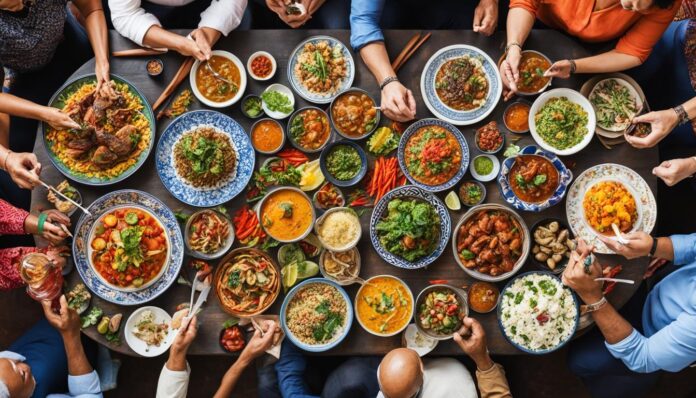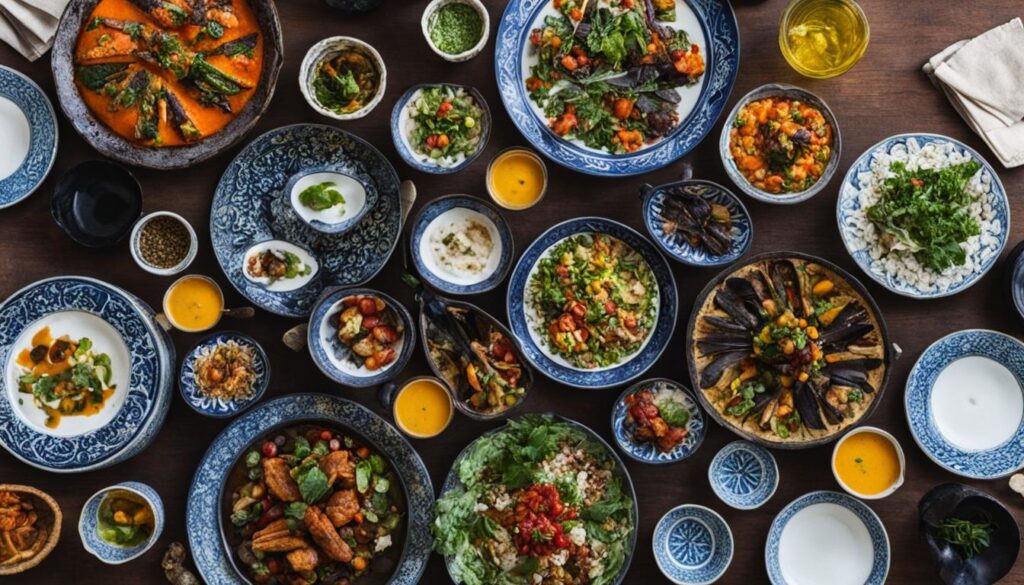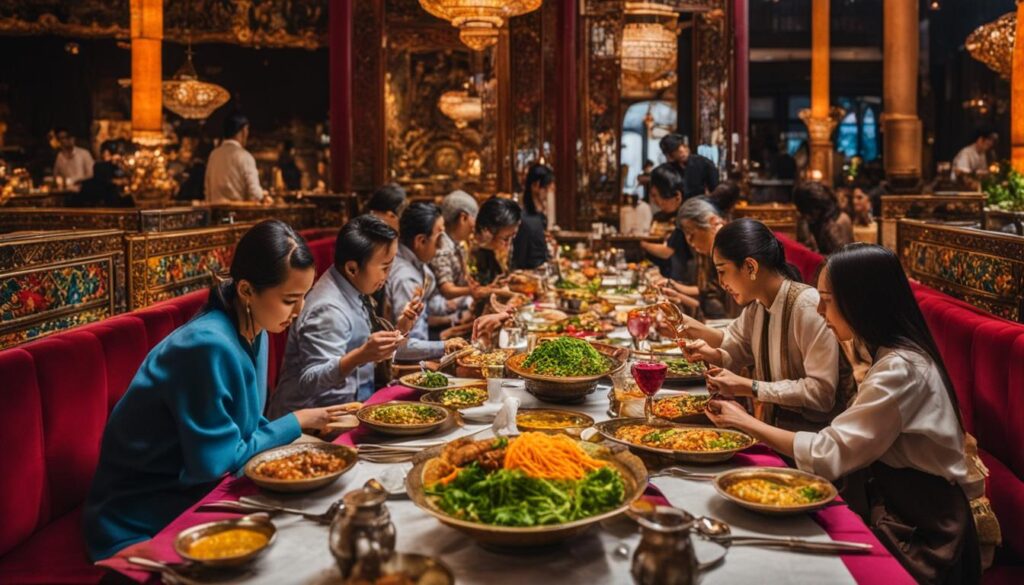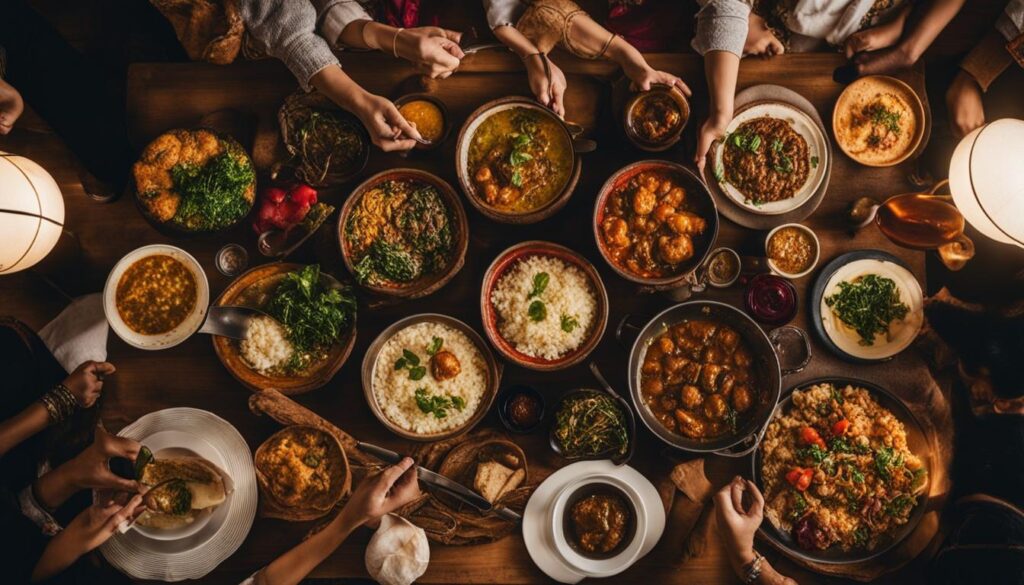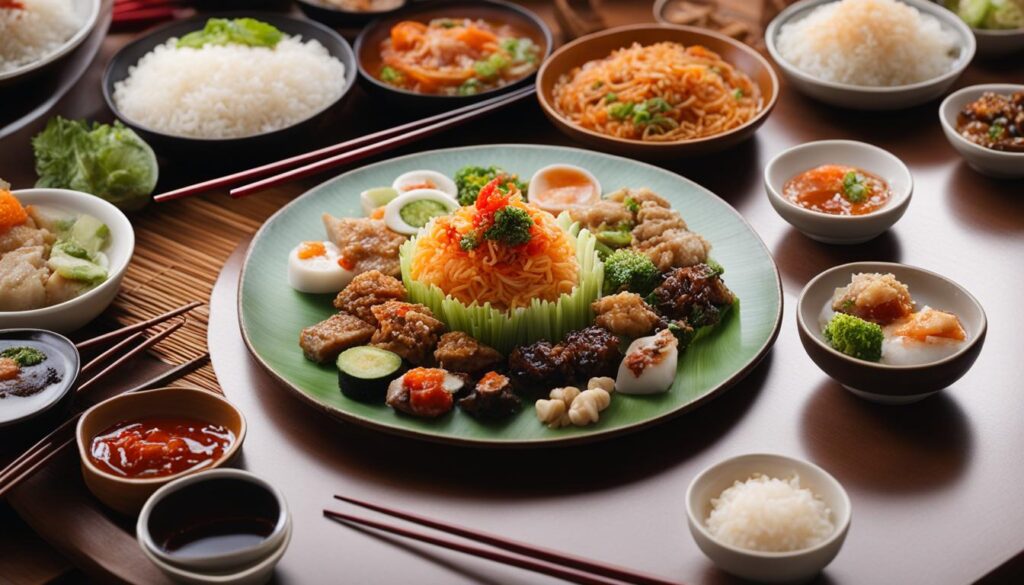When traveling to foreign countries, it’s important to be mindful of cultural etiquette and food customs. International dining customs and social customs around the world can greatly impact your dining experiences and social interactions. Understanding and respecting these customs can help you navigate unfamiliar cuisines with ease.
For example, in some cultures, it’s customary to remove your shoes before entering a home or restaurant. In others, it’s considered polite to leave a small amount of food on your plate to show that you are satisfied with the meal. Being aware of these customs can prevent unintentional disrespect.
In this article, we’ll explore the importance of cultural etiquette and food customs when dining internationally. We’ll also dive into specific customs in different regions of the world, such as Asia, Europe, Africa, Latin America, and Oceania. By the end of this article, you’ll have a better understanding of how to navigate international dining with grace and respect.
Understanding Cultural Eating Habits
When traveling internationally, it’s essential to familiarize yourself with cultural eating habits to avoid unintended faux pas at the dinner table. In every country and culture, there are traditional food customs and dining etiquettes that you need to be aware of before taking your first bite. Understanding these habits is the key to navigating unfamiliar cuisines with ease and respect.
For instance, in Japan, it’s customary to say “itadakimasu” before starting a meal to express gratitude for the food. On the other hand, in Russia, it’s considered rude to keep your hands in your lap while eating. Instead, you should rest your wrists on the table’s edge without your elbows. Differences like this can make a big difference in how you are perceived as a guest at the table, so it’s crucial to know them all before your meal.
It’s also important to note that cultural eating habits can vary based on different social customs within various countries. In some cultures, eating with your hands is proper etiquette, while in other countries, it could be seen as disrespectful.
To ensure that you don’t commit any unintended social faux pas, we’ve compiled a guide to traditional food customs and dining etiquettes worldwide so you can enjoy your meals without worry.
Traditional Food Customs and Dining Etiquettes
| Continent | Country | Food Customs | Dining Etiquette |
|---|---|---|---|
| Asia | Japan | Say “itadakimasu” before meals to express gratitude for the food. | Avoid sticking chopsticks upright in a bowl of rice. |
| Africa | Kenya | Eating with others from the same plate, symbolizing bonding and friendship. | Avoid using your left hand while eating; it is considered unclean. |
| Europe | France | Dipping bread into soup instead of using spoons. | Avoid adding salt or pepper to your food before tasting it. |
| Latin America | Puerto Rico | Sharing food as a sign of hospitality and friendship. | Avoid arriving early to a dinner party; it is considered rude. |
| Middle East | Saudi Arabia | Serving dates as a sign of welcome and hospitality to guests. | Avoid refusing food or drink offered by your host; it is seen as rude. |
| Oceania | New Zealand | Using a “kai” or communal food bowl in social gatherings to promote sharing. | Avoid leaving your plate with food on it after finishing your meal. |
Keep in mind that cultural eating habits and food customs aren’t meant to be restrictive. Instead, they serve as a way of showing respect and appreciation for different cultures. So, take some time to educate yourself on traditional food customs and dining etiquettes before traveling, and you’ll be sure to have a dining experience that’s both enjoyable and respectful.
Dining Customs Abroad
When traveling to another country, it’s important to be aware of the cultural table manners and dining customs that may be different from what you’re accustomed to in the United States. By familiarizing yourself with these customs, you can avoid any awkward or disrespectful situations and enjoy a positive dining experience.
Asia
In many Asian countries, it’s customary to eat with chopsticks and to never leave the chopsticks sticking upright in a bowl. In Japan, it is polite to say “Itadakimasu” before starting a meal and “Gochisousama deshita” after finishing. In China and other countries, it’s important to wait for the oldest or most senior person at the table to start eating before diving in.
Europe
Europe has a diverse range of dining customs, varying from country to country. In France, it’s considered rude to cut lettuce with a knife and fork, while in Italy it’s impolite to order a cappuccino after 11 am. In Germany, it’s common to say “Prost!” before taking a drink, and in Russia, it’s polite to leave a small amount of food on your plate to show that you have been served enough.
Africa
In many African cultures, dining is a communal experience that often involves sharing food from a common bowl. In Ethiopia, it is customary to eat with your hands, using a flatbread called injera to scoop up the food. In Morocco, it’s typical for the host to wash the hands of their guests before they start eating, as a symbol of their hospitality.
Latin America
Latin American dining customs are known for their warmth and hospitality. In many countries, it’s customary to share dishes family-style rather than ordering individual plates. In Mexico, it’s polite to keep your hands visible and to avoid resting your elbows on the table, while in Brazil, it’s common to eat with your hands, particularly when enjoying street food.
Middle East
In Middle Eastern cultures, it is customary to eat with the right hand only, as the left hand is considered unclean. In Iran, the host will often spoon-feed a guest as a sign of respect and hospitality, while in Turkey, it’s traditional to include a variety of small dishes called meze as part of the meal.
Navigating International Food Traditions
When traveling abroad, it’s important to respect and appreciate international food traditions, which vary greatly across cultures. Doing so can greatly enhance your dining experiences and show respect for different customs and traditions.
First and foremost, it’s important to be aware of basic global food etiquette, such as using utensils or eating with your hands. For example, in many Asian countries, it’s common practice to eat with chopsticks, while in the Middle East, diners may use bread to scoop up food. Understanding how to use utensils or other tools specific to each culture’s food traditions can greatly improve your dining experience.
Another key aspect of navigating international food traditions is being aware of the significance of certain dishes or ingredients. For example, certain foods are considered sacred or only eaten during special occasions in different cultures. Researching the cultural significance of dishes and ingredients before traveling can help you appreciate and respect the food traditions of the countries you are visiting.
“The table is a meeting place, a gathering ground, the source of sustenance and nourishment, festivity, safety, and satisfaction. A person cooking is a person giving: Even the simplest food is a gift.” – Laurie Colwin
Finally, when dining abroad, it’s important to be aware of different dining customs and practices. For example, in some cultures, it’s considered polite to leave a small amount of food on your plate to show that you have had enough to eat, while in others, it’s customary to finish everything on your plate. Recognizing and following these customs can help you show respect for the traditions of the country you are visiting.
By respecting international food traditions and navigating different dining customs, you can not only enjoy diverse cuisine but also show respect and appreciation for different cultures.
Asian Food Customs and Etiquette
Asian food customs and dining etiquette vary widely across the continent. A fundamental aspect of Asian culture is respect for elders and authority figures, often extended to hosts and senior guests at meal times. When dining with local families or at traditional restaurants, it is customary to remove your shoes before entering, as a sign of respect and cleanliness. This practice also applies to some modern venues.
One common custom in many Asian countries is the use of chopsticks as the primary eating utensil. For those who are not familiar with chopsticks, it’s best to observe others and ask for guidance. Different countries may have unique customs and taboos around chopstick use, such as passing food directly with chopsticks or leaving them sticking upright in a bowl, which is considered rude in Japan.
Also, taking small bites and eating quietly is a mark of respect and appreciation for food in many Asian cultures. Burping or making loud noises while eating is seen as impolite. It is better to wait for the host to begin eating, and after taking a bite, to wait for the guests to start eating.
“In Vietnam, it is common practice to drink tea before and after meals as it aids digestion. Drinking water during meal times is generally avoided as it could dilute the stomach acid and slow down digestion.”
Asian Dining Etiquette
| Country | Etiquette and Customs |
|---|---|
| China | The host will likely serve food to guests, and it is polite to try every dish served. Leaving a little bit of food on your plate shows that you have been amply satisfied. Tipping is not customary in China. |
| Japan | It is customary to say “itadakimasu” before eating to show appreciation for the meal, and “gochisosama deshita” after finishing to thank the host. Pouring soy sauce directly on rice is considered impolite in Japan. Instead, put some soy sauce on a separate plate and dip the pieces of sushi or sashimi in it before eating. |
| India | Cutlery is not typically used in India, and many meals are eaten with your hands. Always use your right hand rather than your left, which is considered unclean. Additionally, it is customary to leave a little food on your plate as a sign that you have had enough. |
European Dining Etiquette
Europe is home to a plethora of dining customs and table manners that vary widely across the continent. To ensure a smooth dining experience, it’s essential to be aware of these customs and practice proper European dining etiquette.
Common European Dining Practices
| Dining Practice | Explanation |
|---|---|
| Table Setting | In most European countries, utensils are placed in order of use, with the main course fork and knife placed at the center of the place setting. Bread plates are located to the left of the dinner plate, and glasses are placed directly above the knives and spoons. |
| Toasting | Toasting with wine or champagne is a significant part of European dining culture. Raise your glass and make eye contact when toasting. It’s customary to say “cheers” or “prost” before taking a sip. |
| Sitting and Serving Order | Wait to be seated by the host or hostess. In formal dinners, the man seated to the right of the hostess is considered the guest of honor. In most European countries, the host begins serving the meal, starting with the guest of honor. It is customary to wait for everyone to be served before eating. |
Keep in mind that dining customs can vary from country to country. For example, in France, it’s considered rude to cut lettuce with a knife, while in Italy, it’s customary to only use a spoon for pasta. Taking the time to research the specific dining customs of the country you’ll be visiting can help you avoid any cultural missteps.
By practicing proper European dining etiquette, you can make the most of your dining experiences and show respect for the culture and traditions of the countries you’re visiting.
African Food Traditions and Customs
African food traditions are diverse and vibrant, reflecting the continent’s rich culture and history. One of the key elements of African dining customs is communal eating, which emphasizes the importance of sharing food with others. Family and community gatherings often revolve around large, communal meals, with everyone contributing to the preparation and consumption of the food.
Traditional dishes vary widely by region and culture. For example, in North Africa, couscous is a staple food, while in West Africa, jollof rice is a popular dish. Other notable dishes include injera in Ethiopia and South Sudan, tagine in Morocco, and biltong in South Africa. African cuisine often involves a combination of aromatic spices, bold flavors, and hearty ingredients such as grains, vegetables, and meats.
Eating customs in Africa also vary widely among cultures. For example, in some regions, it is customary to eat with your hands, while in others, utensils are used. It is also considered respectful to eat everything on your plate, as leaving food behind can be seen as wasteful and disrespectful to the person who prepared the meal.
“African dining customs emphasize the importance of sharing food with others.”
Latin American Dining Customs
If you’re planning on dining in Latin America, it’s important to familiarize yourself with the local dining customs and traditions. Latin American food is diverse and full of flavor, reflecting the cultural heritage of the region.
One of the most significant dining customs in Latin America is sharing meals with friends and family. Mealtimes are seen as a way to build and strengthen relationships, and people take great pride in preparing and sharing flavorful dishes.
Hospitality is also highly valued in Latin American dining. Whether in a home or a restaurant, diners are warmly welcomed and treated as honored guests. It’s common for hosts to offer plenty of food and drink, even insisting that guests have seconds or thirds.
When dining in Latin America, it’s also important to know that table manners can vary from country to country. For example, in Mexico, it’s common to use tortillas to scoop up food, while in Argentina, using your hands is generally frowned upon. It’s always a good idea to observe local diners or ask for guidance if you’re unsure.
Middle Eastern Food Etiquette
When dining in Middle Eastern countries, it’s important to be aware of the cultural customs and etiquette related to food and hospitality. Middle Eastern food etiquette is based on sharing and hospitality, and guests are often treated like royalty. You should always show gratitude and respect towards your hosts, and it’s common to bring a small gift or sweet treat to show your appreciation.
Middle Eastern Dining Customs
In Middle Eastern cultures, sharing food is a central part of the dining experience. Dishes are often served family-style, and it’s customary to eat with your hands, especially when eating bread or dipping sauces. When dining in a group, it’s common for everyone to share from the same plate or platter, so it’s important to wait your turn and not take more than your fair share.
Another important aspect of Middle Eastern dining customs is the use of bread. Bread is considered a symbol of hospitality, and it’s traditional to break off a piece of bread and use it to scoop up food or sauce. When accepting food or drink, it’s also polite to use your right hand, as the left hand is considered unclean in many Middle Eastern countries.
Traditional Middle Eastern Dishes
Some of the most popular Middle Eastern dishes include hummus, tabbouleh, falafel, shawarma, and kebabs. When dining in Middle Eastern countries, it’s important to try these traditional dishes and show your appreciation for the local cuisine.
Overall, Middle Eastern food etiquette is all about hospitality, sharing, and respect. By following these cultural customs and being mindful of traditional dishes, you can enhance your dining experience in Middle Eastern countries and show your appreciation for the local culture.
Oceanic Food Customs and Etiquette
Oceanic food customs and dining etiquette are an intriguing mix of indigenous, Asian, and Western influences. While each Oceanic culture has its unique practices, there are some common themes that are worth exploring.
Focusing on Sharing
One of the most noticeable aspects of Oceanic food customs is the emphasis on sharing. In Polynesian and Melanesian cultures, eating is a communal affair that celebrates togetherness and social harmony. For example, in a Tongan feast, known as a lavish, locals prepare and share dozens of dishes, ranging from suckling pig to taro leaves.
“Cooking and feeding in our tradition was love. It was all about the love and keeping the family together.” – Chef Robert Oliver, a Fijian-New Zealand cook, and author of “Me’a Kai: The Food and Flavours of the South Pacific.”
In Samoa, a similar feast is known as an umu, where the food is cooked in a traditional earth oven, and families come together to share plates of fresh fish, taro, and coconut cream. Even in Australia and New Zealand, the concept of BBQs has evolved into a way of enjoying good food and company with friends and family.
Respect for the Environment
Another important aspect of Oceanic food customs is respect for the environment and the connection between land and food. For example, in Hawaii, the ancient Hawaiian concept of ahupua’a emphasizes the sustainable use and management of natural resources, from the mountains to the sea, ensuring that nothing goes to waste.
In Australia and New Zealand, the indigenous Maori and Aboriginal cultures share similar values. The Maori concept of kaitiakitanga promotes environmental guardianship through practices like rahi fishing, which involves catching only mature fish, leaving the younger fish to reproduce and grow.
A Celebration of Seafood
Given that most of Oceania is made up of Pacific Islands, it should come as no surprise that seafood is a major component of the local cuisine. From raw fish dishes like poke in Hawaii to kakoda, a Fijian dish made of coconut milk and raw mahi-mahi fish, seafood is at the heart of many Oceanic food customs.
Overall, Oceanic cuisine offers a fascinating blend of cultural traditions, environmental consciousness, and seafood-centric dishes. By embracing the shared dining experiences and respect for the environment, you can thoroughly enjoy your meals while appreciating and understanding the unique customs of the Oceanic region.
Conclusion
Congratulations! You have gained invaluable insights into cultural etiquette and food customs around the world. By being mindful of different traditional practices and customs, you can enhance your dining experiences and social interactions, whether at home or abroad.
Remember to always show respect for different traditions and cultures when traveling and dining internationally. Take the time to familiarize yourself with the various dining etiquettes and customs of the countries you visit, and be open to trying new foods and experiences.
Navigating cultural etiquette and food customs can seem overwhelming, but it’s an essential part of learning about and respecting different cultures. By incorporating these practices into your dining experiences, you can gain a deeper understanding of the world around you and have a more enriching cultural experience.




























